Air Conditioning and Security Personnel in Proposed 2019-20 School Budget
- Details
- Written by: Joanne Wallenstein
- Hits: 4924
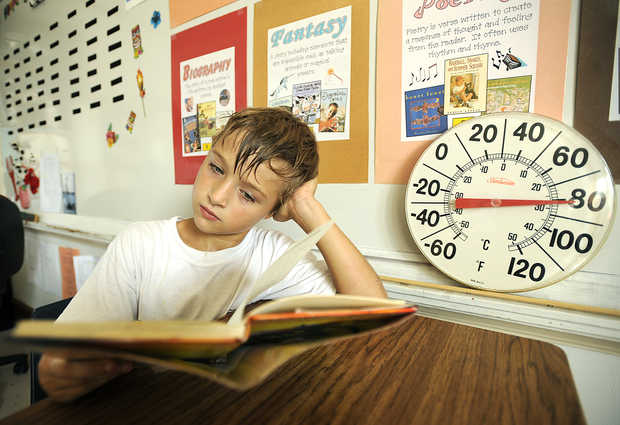 In response to parents concerns about overheated schools on hot days and school security, the school administration is addressing both concerns with funding in the proposed 2019-20 school budget.
In response to parents concerns about overheated schools on hot days and school security, the school administration is addressing both concerns with funding in the proposed 2019-20 school budget.
At the budget study session on Monday night February 4, Assistant Superintendent Andrew Patrick presented a plan for heat relief on days where the temperature soars to 90 degrees and above.
Patrick explained that the district has surveyed all buildings to determine the number of spaces that are currently cooled and to assess how individual air conditioning units could be used to cool enough space so that every student would have access to a cooled room, even if “that means sharing a large instructional space.”
In order to address the shortfall of cool rooms, the district is proposing to add 55 window air conditioners “strategically placed” across the district with split units for the Heathcote pods common spaces. Though they acknowledge this is a short-term solution, the units have an expected lifespan of seven years and will give the district more time to come up with a longer terms solution.
The cost to install these units is estimated at $310,000 and the money would be taken from the surplus funds allocated for Butler Field. The cost to air condition the entire district is estimated to be $45 million.
In addition to these units, both the Quaker Ridge and Fox Meadow libraries would be air conditioned so that they would be on parity with other schools, where the new library at Edgewood is air conditioned and there are plans to air condition the Greenacres library during the upcoming renovation. The cost to cool the Quaker Ridge and Fox Meadow libraries is estimated at $385,000.
For the longer term, Patrick said the district is working with Con Edison Solutions to come up with sustainable plans to cool educational spaces.
In the discussion that followed the proposal, Board Members had some comments.
Lee Maude said, “My gut reaction is that a wall unit is a good solution for something that happens 8 days a year as opposed to $45 million to cool the whole district.”
Chris Morin asked, “What are you thinking about the gyms?” He was told, “It’s part of the long term plan.”
Bill Natbony said, “I have a concern overall about the dollar amounts when I see $600,00 for a piecemeal approach that may or may not be part of a permanent solution.” ….”The public has said to us that this is a high priority item. I think we owe it to them to get to a long-term solution more quickly. I wonder if we can hold off on the $600,000 expenditure now for a longer-term solution more quickly. I see this as patchwork that may not be part of the long-term solution.”
The $695,000 for cooling is now in the estimated budget and will continue to be considered in the scope of the total budget.
School Security
Increased security is also in the proposed budget.
The district is considering both additional mental health and emotional support for students along with infrastructure improvements and safety personnel on site at each building.
Toward that goal, the district hopes to retain one additional full time psychologist and an additional teacher at SHS for academic support.
In terms of building security, the district plans to have two contracted security staffers at each elementary school building to cover the buildings for 16 hours a day and remain at the schools until 5 pm. “Their roles would be to manage the new security vestibules and to be an indoor and outdoor roving safety security monitor.”
At the middle school an additional safety person would allow for coverage from the early morning to the early evening when there are a large number of student related activities. Total safety personnel at the school would be two.
And the high school, two security guards would monitor entrances from early morning through the evening and there would be 16 hours of coverage on Saturdays when the building is open for athletics and other activities.
The total cost for the security measures are as follows: Note that the $186,624 for Mike Spedaliere, the Chief of Safety, Security and Emergency Management from Altaris, is already in the 2018-19 school budget.
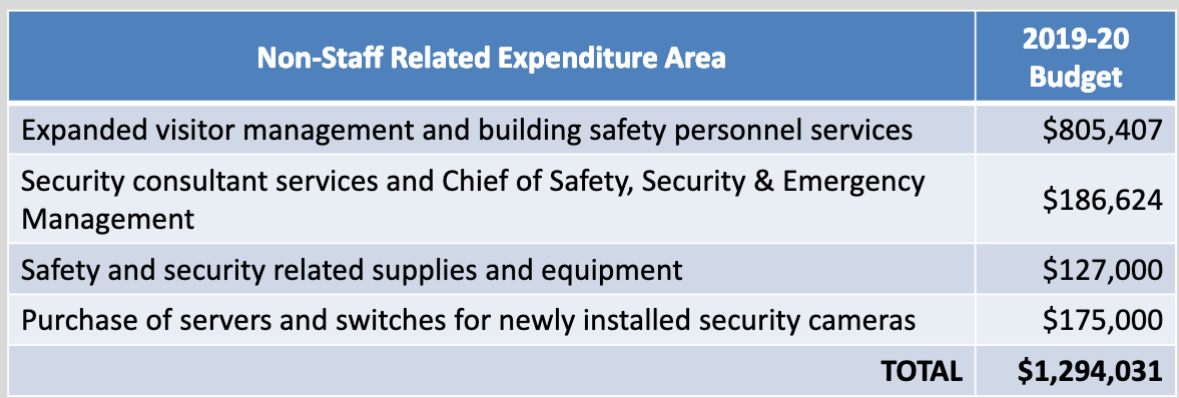
In the discussion that followed, Board member Chris Morin said, “I understand the need for security personnel – but I am not sure of the need for 2 at each school.”
He continued, “Why is our visitor flow so large that we require two? Can we have relief by the office staff? It seems like an awful lot of resource to manage a simple problem. Now that we have vestibules, cameras and buzzers, do we really need so many new people carrying out activities that we have been carrying out?”
Stuart Mattey responded, “These are enhanced activities – carried out in the best way possible. The second person will look outward to see what’s going, on .. speak to a stranger that might be walking through the park. Checking the doors inside the building to make sure they are closed.”
Dr. Hagerman explained, “There are more functions to this role than visitor management during the school day. What about a weekend play practice? Who is managing the door and helping out during an emergency. We also think there is high value in having a rover. Almost all schools have many community events which require a large amount of people to come in and use the schools.”
These funds will also be considered in the context of the entire budget at future budget study sessions. See more details on the proposals here.
BOE Takes a First Look at Estimated Budget and Staffing for the 2019-20 School Year
- Details
- Written by: Joanne Wallenstein
- Hits: 4381
The Board of Education received a first look at the estimated school budget for the 2019-20 school year and reviewed staffing requests for next year at their meeting on January 28, 2019.
Here are the numbers from the initial budget estimate as presented by Assistant Superintendent Stuart Mattey:
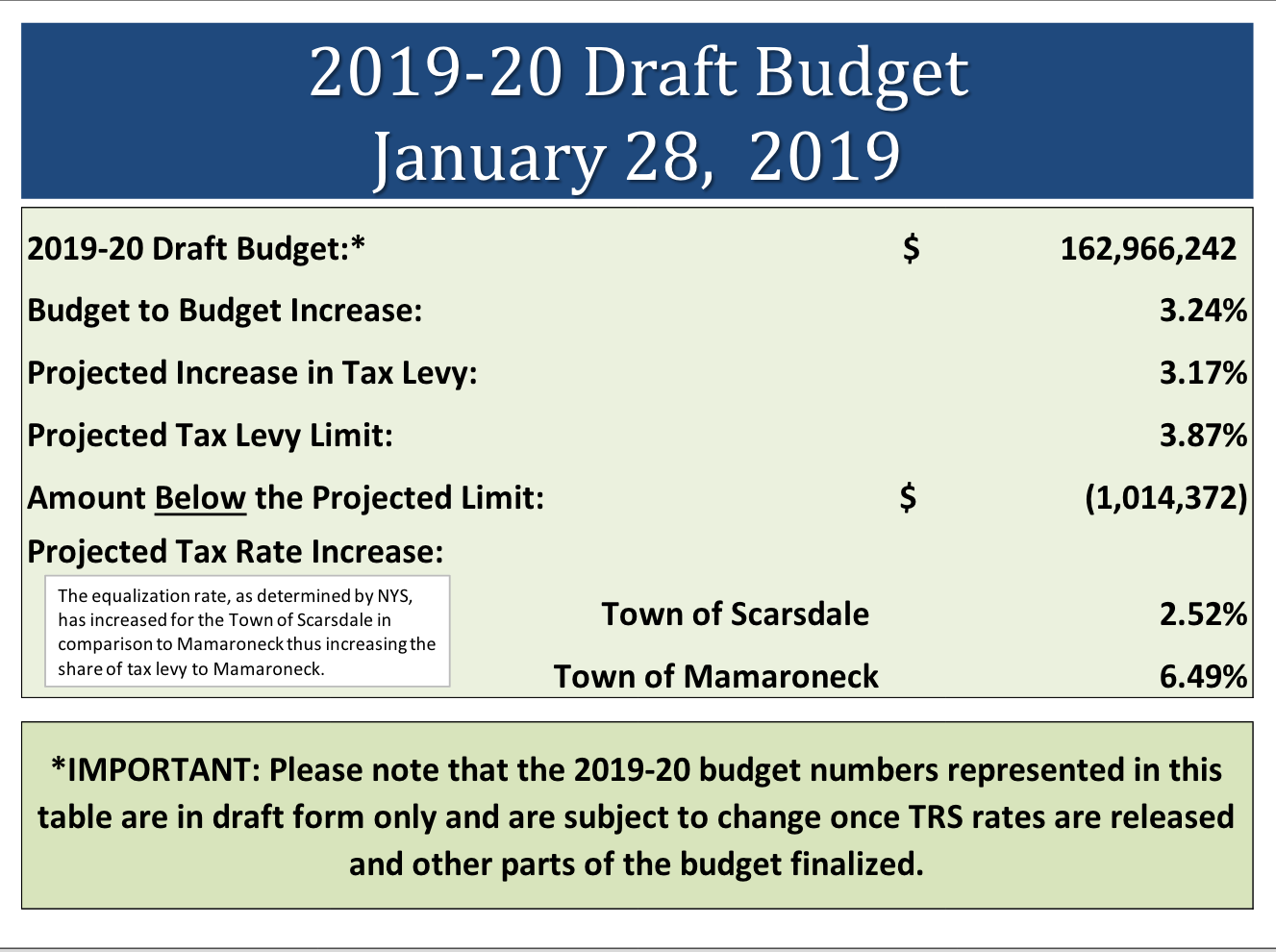
Mattey explained that the higher than usual tax levy limit of 3.87% number is due to the CPI, tax base growth number and the allowable exclusion of debt service. This projected budget is $1,014,372 below the tax levy.
Increase for Scarsdale residents 2.52%
Increase for Mamaroneck strip 6.49%
Why the large difference in the increase in the tax rates between Scarsdale (2.52%) and Mamaroneck (6.49%)? These are due to the equalization rates for the two towns, which are 100% for the town of Mamaroneck and 94% for Scarsdale.
He also noted that the state has not yet set the rates for the Teacher’s Retirement System (TRS), so this projection estimates a 9% increase.
The discussion then turned to staffing which is a primary driver of the school budget.
Staffing at the elementary schools is down 4.1 full time employees (FTE’s) from the 2018-19 budget, with elementary school staffing at 191 FTE’s rather than the 195 FTE’s anticipated in the 2018-19 budget.
The administration made the following requests for additional staffing for the 2019 school budget. The cost of an additional employee is estimated at $110,000. See the full presentation here:
At the high school an additional science teacher is needed to “accommodate research and AT program expansion and to reduce the size of AT and accelerated courses.”
Also at the high school a full time math teacher is needed to teach STEAM and math courses. Currently there are 2 section of BC Calculus, each with 27 students and the high school anticipates that three sections will be needed next year. The school was not able to offer an honors math interdisciplinary course this year due to staffing. An increased number of sophomores are enrolled in STEAM electives, and would benefit for more STEAM offerings as they become upper classmen. The school hopes to offer an elective in APP development and may need to offer a second section of AT Entrepreneurship.
The administration is requesting an additional special education teacher at the high school for the Academic Support Center (ASC). This teacher would help students who are not classified but need additional support transitioning to the high school. The center assists students with navigating the curriculum and executive functioning.
The physical education department is requesting an additional .28 office assistant to manage reporting, gold cards, calendars, travel waivers and special projects.
At the middle school, a technical support person is needed to assist with the 1:1 iPad program. The full time support person would replace one aide and one tech summer intern so that the addition cost to the district would be $30,750.
An additional school psychologist has been requested for the elementary schools and central office for students “experiencing social, emotional or behavioral issues that would not currently rise to the level of direct psychological intervention….to focus on coping strategies, understanding differences and developing age appropriate peer to peer relations.”
The total cost for this additional staffing would be $256,550.
In the discussion following the proposal board members posed some questions about the additional staff requests.
Lee Maude noted that for the 2018-19 school year the district budgeted and taxed on a total of 624 employees, but primarily due to the drop in enrollment only hired 619. She asked, “Don’t we already have funding for new teachers for next year?"
Stuart Mattey explained that these staffing requests were additions to the actual staffing this year – not the budgeted number. He said, “Any funds left go into the fund balance.” Nina Cannon followed up, asking, “Can we use fund balance to offset the cost of the increase of hiring new FTE’s?” Mattey replied saying, “The fund balance is also affected by other budget factors and might not completely cover the staffing increase.” Adding, “You don’t want to use unassigned funds to fund ongoing expenses.” … “Typically we have about $1.1 million to use as unassigned fund balance and spend on facilities or plant improvements.”
Bill Natbony said, “I have trouble making decisions on staffing without the total picture of the budget. If the TRS increase goes down, that’s $700,000 that we could spend on staffing. The projected increase does not reflect the money in the fund balance – which we did not spend this year. I am not comfortable giving a nod to staff increases until I know where we are overall….Are we going to spend more on security? Until we have this broad based discussion I can’t in good conscious say let’s put this staffing in the budget.”
Pam Fuehrer asked Principal Bonamo, “I just want to be sure you have looked at your resources and are allocating them to their maximum capacity." Bonamo said, “Yes – we have reassigned two of our teachers – one math teacher is teaching Physics to allow the science teacher to teach a STEAM class. We have reached our capacity to make assignments to meet student needs. Without these additions, students will not be able to get the classes they requested. We are projecting an increase in demand in STEAM courses. About 98% of students get into the classes they request. ….Nearly 60 students are in high honors pre calc who will roll over into BC Calculus…. For Bio 513 we sometimes allow larger classes, projecting that some students will decide to move down. We try to be as frugal as we can in the use of resources.”
Lee Maude continued, “What we are not talking about is equity – the courses we are talking about tonight are not available to every child in the high school and I am troubled about this. These are not for 80% of our kids who can’t get into AT classes. It’s an issue for me if we don’t let kids take the classes that interest them.”
Bonamo responded, “By increasing the teaching power you are impacting the department overall because you are impacting all section sizes. … Students are placed in math levels in middle school. We do keep access open in high school. If they do summer study they can accelerate to a different level. The chair had 50 kids come in to take a placement tests this summer to jump a level in math. Science and math tend to be more ability based and leveling is appropriate.”
Assistant Superintendent Drew Patrick reminded the board about the assumptions underlying district staffing. He said, “Three things drive staffing:
-Class size maximums at elementary level
-The Middle School house and team structure
-At the High school – the course catalogue drives staffing
If we questions assumptions, we should go back to the underlying assumptions.”
In the coming weeks, the Board of Education has a series of budget study sessions scheduled to review major areas of the proposed 2019-20 school budget. These staffing requests will be reviewed again in light of the outcome of those discussions.
Scarsdale Track and Field Shatters School Records, Qualifies for Millrose Games and Qualifies for Nationals
- Details
- Written by: Alex Wilson
- Hits: 5740
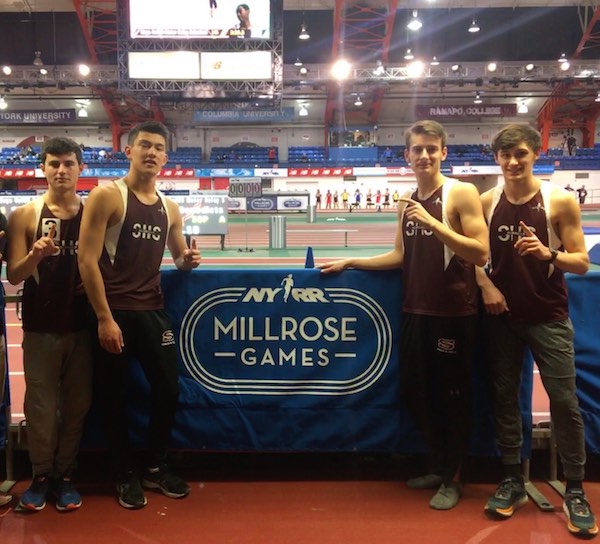 Boys 4x400 Relay Team (Left to right) Jonah Oxman, Nick Bernard, Eric Jacobson, and DJ Matusz.Even without a track at their disposal, the Scarsdale track and field team has had an exciting start to their winter season, with many individual athletes achieving high rankings in the section, state, and even nationally.
Boys 4x400 Relay Team (Left to right) Jonah Oxman, Nick Bernard, Eric Jacobson, and DJ Matusz.Even without a track at their disposal, the Scarsdale track and field team has had an exciting start to their winter season, with many individual athletes achieving high rankings in the section, state, and even nationally.
When the Scarsdale track and field coaches learned that they would not have a track at the high school for the winter and possibly spring seasons, they had to problem-solve and create a training plan that did not require the track. The solution amounted to sprint workouts on Dean Field, weekly trips to the track at Edgemont High School, and more runs on the roads. “Although there are some challenges, the coaches and runners have all stayed positive this season to stay competitive,” said Captain Sierra Donovan ’19. This altered training schedule was an adjustment for the athletes, but that did not prevent many of them from excelling.
The track team’s winter season is long, cold, and intense, so to avoid injuries and burnout, the coaches chose to put fewer meets on the schedule this year. However, the meets Scarsdale has attended have been exciting and action-packed. In just the first meet on December 9th, Sophia Franco ’20 ran a blistering 1:34.07 in the 600 meter dash -- at the time, the fastest time in the country and a new Scarsdale school record. She is currently ranked fourth nationally and looks forward to competing in that event at Nationals in March.
Franco will not be the only Scarsdale runner in attendance: at the Millrose Trials on January 9th, the boys’ 4x400 relay qualified for the elite Millrose Games and Nationals with a time of 3:27.77. DJ Matusz’s ’20 opening leg of 53.367 seconds started strong, followed by Nick Bernard (49.887 seconds), then Jonah Oxman ’19 (53.753 seconds) and a strong anchor leg by Eric Jacobson ’19 (50.763 seconds). “Mod [Coach Modafferi] told us individually what our race strategies were going to be, and we executed that plan well, which allowed us to run fast,” said Jacobson when reflecting on the meet. When the boys arrived at practice the next day, Coach Modafferi surprised them with news that their race also broke the school record.
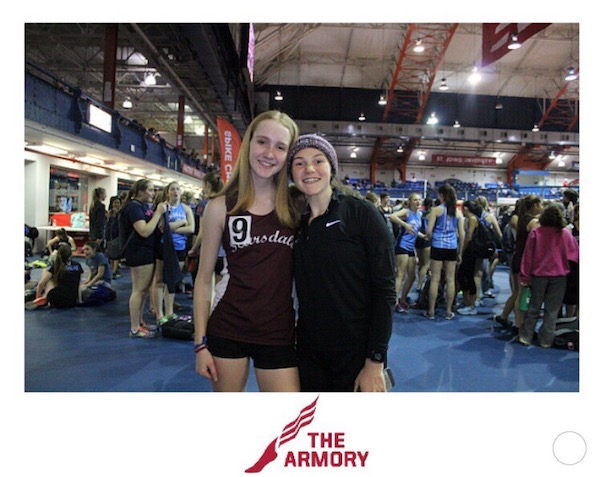 Long-distance runners Lizzie Hurshman ‘22 and Caitlin Barotz ‘20That weekend at Leagues, Bernard and Jacobson built on their momentum from the Millrose Trials and had stellar 600 meter races. For the entire race, the teammates and close friends were leading the pack in the first heat, pushing each other in each lap. Bernard finished in 1:23.08 and Jacobson right behind him at 1:23.43. These times ranked #21 and #28, respectively, nationally. Running next to each other “definitely helped, as I wouldn't have been able to pace myself if I didn’t have someone right with me the whole time,” said Bernard. Jacobson was happy to run alongside his friend, calling it “a fun race.” The pair hopes to continue improving so that they place well at State Quals and States and have success at Nationals.
Long-distance runners Lizzie Hurshman ‘22 and Caitlin Barotz ‘20That weekend at Leagues, Bernard and Jacobson built on their momentum from the Millrose Trials and had stellar 600 meter races. For the entire race, the teammates and close friends were leading the pack in the first heat, pushing each other in each lap. Bernard finished in 1:23.08 and Jacobson right behind him at 1:23.43. These times ranked #21 and #28, respectively, nationally. Running next to each other “definitely helped, as I wouldn't have been able to pace myself if I didn’t have someone right with me the whole time,” said Bernard. Jacobson was happy to run alongside his friend, calling it “a fun race.” The pair hopes to continue improving so that they place well at State Quals and States and have success at Nationals.
There have been many other notable performances this season that will carry some athletes to State Quals on February 17. On the girls’ side, these include Brooke Bensche’s high jump (5’2”) and 55m hurdles (9.17), Donovan’s 600m (1:41.20), Aliza Mehlman’s 1000m (3:10.32), Franco’s 300m (41.90) along with her 600m, and Victoria Capobianco’s 3000m (11:17.27). Relays that can advance are the 4x200 (1:52.40) and the 4x400 (4:12.51).
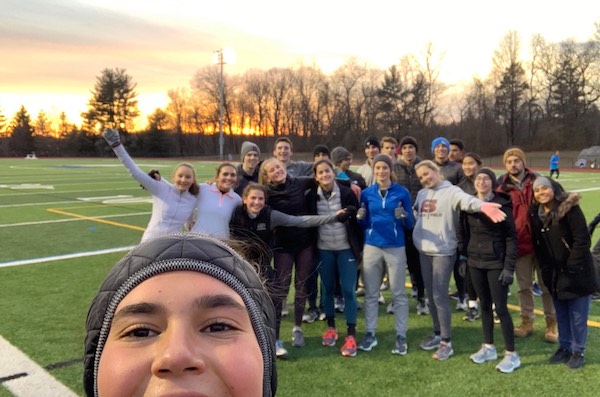 Middle-distance group picture after a workout at the Edgemont High School track Boys’ performances eligible to advance to State Quals include Ward Bandsma’s 1000m (2:41.38) and 1600m (4:41.52), Matusz’s 1000m (2:42.67), Jake Coleman’s 3200m (10:06.70), Andrew Levy’s 3200m (10:13.06), Bruno Tassari’s 3200m (10:17.23), Jacobson’s 300m (37.32) and 1000m (2:38.80) as well as his 600m, and Bernard’s 1000m (2:37.68) as well as his 600m. Relays that can advance are the 4x800 (8.22.05) and the 4x400.
Middle-distance group picture after a workout at the Edgemont High School track Boys’ performances eligible to advance to State Quals include Ward Bandsma’s 1000m (2:41.38) and 1600m (4:41.52), Matusz’s 1000m (2:42.67), Jake Coleman’s 3200m (10:06.70), Andrew Levy’s 3200m (10:13.06), Bruno Tassari’s 3200m (10:17.23), Jacobson’s 300m (37.32) and 1000m (2:38.80) as well as his 600m, and Bernard’s 1000m (2:37.68) as well as his 600m. Relays that can advance are the 4x800 (8.22.05) and the 4x400.
With the County Meet coming up on Sunday January 27 and the Class A Meet the following weekend, the team hopes to continue improving and motivating each other so more Raiders can advance to State Quals and beyond.
Demographer Provides 5-Year Enrollment Projection for the Scarsdale Schools
- Details
- Written by: Joanne Wallenstein
- Hits: 9243
 It was somewhat of a surprise last spring to learn that projected enrollment for kindergarten in Scarsdale was down – way down. Though traditionally each elementary school had three kindergarten classes, a steep dip in 5 year olds – and their parents – caused kindergarten enrollment to drop by 66 students for the 2018-19 school year. This meant three fewer kindergarten class sections and concern about what the long-range picture might be.
It was somewhat of a surprise last spring to learn that projected enrollment for kindergarten in Scarsdale was down – way down. Though traditionally each elementary school had three kindergarten classes, a steep dip in 5 year olds – and their parents – caused kindergarten enrollment to drop by 66 students for the 2018-19 school year. This meant three fewer kindergarten class sections and concern about what the long-range picture might be.
Administrators conjectured that changes in the tax laws had discouraged home buyers. A trend to keep children in preschool for an additional year had delayed enrollment in school and also contributed to the dip.
Now, as the district begins the budgeting process for 2019-20, Assistant Superintendent Drew Patrick invited demographer Richard S. Grip to attend the January 14 meeting of the Board of Education and present his projection of five-year enrollment trends for Scarsdale.
Why can he only project for five years? Grip had a very good response. He explained that a big factor in enrollment projections are birth rates. Given that kindergartners are only five when then enter school, he said it was difficult to project enrollment of those who have not yet been born.
Before discussing projections, Grip provided a demographic analysis of the Scarsdale community, based on numbers from the 2012-2016 American Community Survey. Here are a few interesting facts:
Diversity: The community as of 2016 was 81.4% White and 14% Asian. 22.9% of residents were foreign born.
Residents are highly educated – 87.9% have a bachelors degree and 57.2% have a graduate or professional degree.
The median family income was reported at $250,000 plus.
There were 5,863 households with a median value of $1,311,900.
Grip also provided an analysis of the age distribution of Scarsdale’s population and it was interesting to note the large population of children and adults from 40 – 60, with a pronounced dearth of residents between the ages of 20 -35.

Turning to his projections, Grip introduced the concept of “Kindergarten Replacement” saying, “The district has experienced negative kindergarten replacement in eight of the last nine years. Negative kindergarten replacement occurs when the number of graduating 12th grade students is larger than the number of kindergarten students replacing them in the next year.” He said Scarsdale has experienced negative kindergarten replacement in eight of the last nine years. However, these losses were partially offset by children who moved in for higher grades and reduced the overall loss.
Using data about births, fertility, housing starts and home sales Grip provided projections for the school population for the next five years. His medium projection forecasts expects to see a decrease of 227 students in the next five years. He anticipates that the total school population will drop from 4,683 in 2019-20 to 4,456 in 2023-24. Between 2009 and 2018, overall enrollment in the Scarsdale Schools ranged from a low of 4,726 to a high of 4,821, so these new numbers are somewhat sobering.
His projections for incoming kindergartners hold steady at around 280 per year, which is higher than the 259 students enrolled this school year, but nowhere hear 2013-14 when 350 students enrolled.
Despite this dip, overall, Grip was very optimistic about the future of the district. He said, “This is an excellent district and people are clamoring to get in.”
Twelve Elected to School Board Nominating Committee
- Details
- Written by: Joanne Wallenstein
- Hits: 7800
 Twelve candidates were elected on January 8, 2019 to join the Scarsdale School Board Nominating Committee for 2019.
Twelve candidates were elected on January 8, 2019 to join the Scarsdale School Board Nominating Committee for 2019.
Here’s who will serve:
Edgewood: David Benderson and Amy Schiff
Fox Meadow: Laura Gelblum and Seema Jaggi
Greenacres: Todd Cohen, Jennifer Fischer and Xue Su
Heathcote: Anirudh Bansal, Chris Marks, and “Laura” Ying Liu
Quaker Ridge: Ekta Sahni and Rob Tepper
This year’s new members will join the existing SBNC members of the committee serving staggered three-year terms. Note that Todd Cohen will serve a 2 year term in Greenacres, Anirudh Bansal will serve a 1 year seat in Heathcote, and Rob Tepper will serve a 2 year term in Quaker Ridge.
Though the administrative committee seeks to run a contested election, this year they struggled to find residents who were willing to serve and all the candidates ran unopposed.
Wendy Gendel, who chairs the Administrative Committee of the SBNC reported that a total of 240 votes were cast in the election, of which six were mail-in ballots.
Here is the breakdown of votes cast by neighborhood:
Edgewood: 25
Fox Meadow: 38
GreenAcres: 61
Heathcote: 73
Quaker Ridge: 43
Though the PT Council scheduled a meeting at the middle school on the evening of the vote to encourage participation, the vote count was markedly lower than in previous years. In 2018 460 votes were cast and in 2017, 355 residents voted.
The committee will have its first meeting on January 13, 2019 and by the end of March it will nominate 3 candidates for the Scarsdale Board of Education to fill the seats currently held by Nina Ledis Cannon, Leila Maude, and William (Bill) Natbony. All Scarsdale residents are welcome to propose Board of Education candidates to the SBNC. The SBNC Board of Education candidates, along with any other candidates who may choose to run, will stand for public election in May at the same time as the school budget vote.










